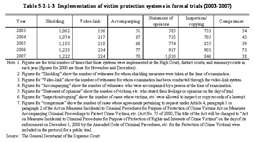| Previous Next Index Image Index Year Selection | |
|
|
2 Victim protection, etc. in public trials Also, the court shall give victims, etc. the opportunity to state their opinions, in principle, on the date of trial if they offer to express their feelings about damage and opinions on the cases. Furthermore, the defendants and victims, etc. in a criminal case may jointly request that any agreement reached between them in a civil dispute related to the criminal case be included in the protocol for a public trial. Any such agreement included in the protocol has the same effect as a judicial compromise. Hence victims, etc. can take compulsory execution procedure using the protocol for a public trial without initiating a separate civil lawsuit if the defendants fail to perform the agreed duties. Conventionally, courts in charge of criminal cases in progress may allow victims to inspect or copy the records of a lawsuit between the first public trial and the closing of the lawsuit, only if the victims request such inspection or copying and the courts find sufficient grounds to grant such requests, such as being necessary to exercise their rights to claim compensation for damage. The scope of such services was expanded by the Act for Partial Amendment to the Code of Criminal Procedures etc. for the Protection of Rights and Benefits of Crime Victims (Act No. 95 of 2007; hereinafter referred to as the “Amended Code of Criminal Procedures, etc. for the Protection of Crime Victims” in this subsection) which was promulgated on June 27, 2007, and starting in December 26 of the same year the courts shall, in principle, allow victims, etc. of criminal cases to inspect or copy the records, and the courts may also allow victims, etc. of other crimes of similar kinds by the same defendants to inspect and copy the records, if the courts consider it necessary and appropriate for exercising their rights to claim compensation for damage. Table 5-2-1-3 shows the implementation of the above-mentioned systems over the last five years. Table 5-2-1-3 Implementation of victim protection systems in formal trials (2003–2007) In contrast, records of cases of non-prosecution shall not be disclosed in principle. However, there are cases where victims, etc. needs objective evidence such as on-the-spot investigation reports, investigation reports on taking photographs, and post-mortem examination reports to exercise their rights to claim compensation for damage or other rights in civil lawsuits to recover the damage. In light of this, public prosecutors offices admit inspection or copying of such evidence when considering it appropriate without any risk of invading the privacy of any persons concerned. Furthermore, public prosecutors offices provide civil courts with written statements in the record of a case of non-prosecution and information to identify witnesses under certain requirements.Furthermore, the Amended Code of Criminal Procedures, etc. for the Protection of Crime Victims introduced a system wherein the names, etc. of crime victims are protected at criminal proceedings, and has been implemented since December 26, 2007. A system in which crime victims, etc. can participate in criminal trials and a system to utilize the achievement of criminal proceedings concerning claims for damages being made by crime victims, etc. were also established, and were enforced on December 1, 2008. In addition, the Act for Partial Amendment to the Act on Measures Incidental to Criminal Procedures for Purpose of Protection of Rights and Interests of Crime Victims and the Comprehensive Legal Support Act (Act No. 19 of 2008) promulgated on April 23, 2008 will enable victims ,etc. to apply for court-appointed defense counsel for victim participation in the case that victims, etc. need to entrust a defense counsel to participate in criminal proceedings under this system depending on their financial resources. |
